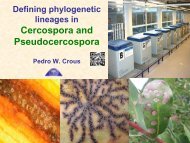DNA Barcode of the Flora of Calakmul, Yucatan Peninsula, Mexico
DNA Barcode of the Flora of Calakmul, Yucatan Peninsula, Mexico
DNA Barcode of the Flora of Calakmul, Yucatan Peninsula, Mexico
Create successful ePaper yourself
Turn your PDF publications into a flip-book with our unique Google optimized e-Paper software.
<strong>DNA</strong> <strong>Barcode</strong> <strong>of</strong> <strong>the</strong> <strong>Flora</strong><br />
<strong>of</strong> <strong>Calakmul</strong>, <strong>Yucatan</strong><br />
<strong>Peninsula</strong>, <strong>Mexico</strong><br />
Lidia I. Cabrera, Gerardo A.<br />
Salazar, Esteban Martínez, Clara<br />
Ramos, Patricia Escalante,<br />
Fernando Chiang, Mario Sousa,<br />
María Kuzmina<br />
1) licabreram@yahoo.com.mx;<br />
2) lcabrera@ibunam2.ibiiologia.unam.mx
Two approaches to barcoding:<br />
• Taxonomic Group<br />
– Expert on a specific taxon<br />
– Large number <strong>of</strong> samples <strong>of</strong> <strong>the</strong> group<br />
• <strong>Flora</strong> (or biota) from a place with<br />
previous botanic knowledge<br />
• Herbarium samples <strong>of</strong>ten available and<br />
already identified by taxonomist
<strong>Calakmul</strong>: part <strong>of</strong> <strong>the</strong> Mayan tropical<br />
forest, second largest rain forest in<br />
<strong>the</strong> Americas after <strong>the</strong> Amazon<br />
<strong>Calakmul</strong> Biosphere<br />
Reserve<br />
•23 398 Km 2<br />
•Limestone substrate<br />
9 types <strong>of</strong> vegetation<br />
Martinez et al. (2001): 147<br />
families <strong>of</strong> land plants,<br />
1537 species (70% <strong>of</strong> <strong>the</strong><br />
flora <strong>of</strong> Campeche).<br />
Imagen de<br />
satélite<br />
I<br />
II
Aims <strong>of</strong> this study:<br />
• Assess <strong>the</strong> potential to barcode a tropical flora<br />
from herbarium specimens.<br />
• Determine <strong>the</strong> performance <strong>of</strong> <strong>the</strong> standard<br />
barcode for land plants (rbcL + matK) for <strong>the</strong><br />
taxonomic discrimination at family, genus and<br />
species levels.
Material and methods<br />
950 herbariums samples from <strong>the</strong> project <strong>Flora</strong> de <strong>Calakmul</strong><br />
(MEXU); 2 samples per species (81 families, 301 genera, 566<br />
species)<br />
Geo-referenced<br />
database,<br />
digital pictures and<br />
traces uploaded to<br />
BOLD<br />
(www.boldsystems.org)<br />
Fragments <strong>of</strong> 5 5<br />
mm (leaf, bract,<br />
tepal)<br />
standard<br />
sequencing<br />
protocols at<br />
Guelph, Canada<br />
Data Analysis:<br />
BLAST in GenBank.<br />
Distance Analysis (NJ, K2P model, for pairwise<br />
genetic distances and <strong>the</strong> threshold for<br />
distances for discrimination with <strong>the</strong> program<br />
Taxon<strong>DNA</strong>).<br />
Parsimony Analysis (bootstrap, 1000 replicates<br />
to assess group support).
Project Specimens<br />
CALAK<br />
<strong>DNA</strong><br />
barcode <strong>of</strong><br />
<strong>the</strong> flora<br />
<strong>of</strong><br />
<strong>Calakmul</strong>,<br />
Sequence<br />
quality<br />
stats<br />
Sequencing Results<br />
Species Species<br />
with<br />
sequences<br />
matK<br />
950 566 367<br />
(64.8%)<br />
Species<br />
with<br />
sequences<br />
rbcLa<br />
449<br />
(79.3%)<br />
Species<br />
with<br />
barcodes(matKrbcLa)<br />
301<br />
(53.65%)<br />
Sequences<br />
matK<br />
531<br />
(55.9%)<br />
High<br />
99.85%<br />
Sequences<br />
rbcLa<br />
675<br />
(71.1%)<br />
High<br />
99.62%<br />
<strong>Barcode</strong>s(matKrbcLa)<br />
403<br />
(42.4%)<br />
(276-933 bp) (390-552 bp)
Taxonomic assignment by<br />
GenBank BLAST<br />
Correct<br />
taxonomic<br />
match in<br />
GenBank<br />
for matK<br />
Correct<br />
txonomic<br />
match in<br />
GenBank<br />
for rbcL<br />
Taxa<br />
correctly<br />
assigned by<br />
matK<br />
Taxa<br />
correctly<br />
assigned by<br />
rbcL<br />
Family level 503 (94.73%) 672 (99.56%) 73 (90.12%) 52 (72.84%)<br />
Genus level 357 (67.23%) 538 (79.70%) 137 (45.51.%) 187 (62.13%)<br />
Species level 98 (18.46%) 147 (21.8%)<br />
68 (12.12%)<br />
89 (15.87%)
matK<br />
531 sequences<br />
rbcL<br />
675 sequences<br />
matK + rbcL<br />
403 sequences<br />
Neighbor joining trees<br />
Trees congruent with<br />
angiosperm<br />
phylogeny (APG III)<br />
Parsimony bootstrap recovers same groups<br />
Family (Bootstrap support)<br />
Acanthaceae (100) Anacardiaceae (100)<br />
Agavaceae (100) Apocynaceae (100)<br />
Araceae (100) Arecaceae (100)<br />
Bignoniaceae (61) Boraginaceae (100)<br />
Bromeliaceae (100) Cactaceae (100)<br />
Canellaceae (100) Cannabaceae (100)<br />
Convolvulaceae (100) Dilleniaceae (100)<br />
Ebenaceae (100) Elaeocarpaceae (100)<br />
Erythroxylaceae (100) Fabaceae (100)<br />
Hypocrateaceae (100) Lauraceae (100)<br />
Malpighiaceace (100) Meliaceae (99)<br />
Moraceae (100) Myrtaceae (100)<br />
Olacaceae (100) Polygalaceae (100)<br />
Polygonaceae (100) Rhamnaceae (91)<br />
Rubiaceae (100) Rutaceae (100)<br />
Sapindaceae (100) Sapotaceae (100)<br />
Solanaceae (100) Sterculiaceae (100)<br />
Violaceae (100) Vitaceae (100)
Distance summary for 403 complete standard<br />
barcodes (matK-rbcL)<br />
400<br />
350<br />
300<br />
250<br />
200<br />
150<br />
100<br />
50<br />
0<br />
Histogram <strong>of</strong> <strong>the</strong> number <strong>of</strong> intraspecific and interspecific comparisons<br />
Series1 Interspecific<br />
Series2 Intraspecific<br />
Overlapping rank between<br />
intra– and interspecific<br />
distances: 0%-0.76%<br />
1.68% “ Best Close Match”<br />
threshold<br />
34.73% <strong>of</strong> species can be<br />
distinguished with this<br />
threshold
General considerations<br />
• High quality sequences <strong>of</strong> rbcL and matK could be recovered for 71%<br />
and 56% <strong>of</strong> <strong>the</strong> sampled herbarium specimens, respectively.<br />
• Complete standard barcodes (rbcL + matK) were obtained for 42% <strong>of</strong><br />
<strong>the</strong> herbarium specimens using standard protocols (i.e. without<br />
additional optimization effort for individual samples).<br />
• Taxonomic assignment by <strong>the</strong> BLAST (GenBank) was high at family<br />
level, lower at genus level and lowest at <strong>the</strong> specific level. This is to be<br />
expected because <strong>the</strong> greater inclusivity <strong>of</strong> higher ranks; however, few<br />
Mexican tropical plants have been sequenced for <strong>the</strong>se markers so<br />
<strong>the</strong>re is little chance <strong>of</strong> a specific match.<br />
• Overlapping between intra-and interspecific distances: 0%-0.76%. The<br />
1.68% threshold (“Best Close Math”) allows distinction <strong>of</strong> 35% <strong>of</strong> <strong>the</strong><br />
species can distinguish with this.
General considerations<br />
• PCR and sequencing optimization would increase <strong>the</strong> yield <strong>of</strong> highquality<br />
standard barcodes from herbarium specimens; although<br />
impractical from a high-throughput barcoding strategy, this would<br />
maximize <strong>the</strong> potential <strong>of</strong> museum (herbarium) collections to advance<br />
in creating reference sequence databases for many tropical areas where<br />
sample collection and identification are expensive and timeconsuming.<br />
• Increased sequencing success would increase intraspecific sampling,<br />
making discrimination thresholds more robust (e.g. for “best close<br />
match”).<br />
• Never<strong>the</strong>less, distinct thresholds seem not to exist for <strong>the</strong> standard<br />
barcode markers for particular groups (e.g. Ficus, Moraceae). In <strong>the</strong>se<br />
cases additional, more variable markers will be necessary for species<br />
distinction.
General considerations<br />
• Herbarium-based barcoding represents a reasonable compromise<br />
between minimizing financial needs (e.g. for collecting expedition an<br />
time consuming, traditional identification) and increased sequencing<br />
effort (PCR and sequencing optimization).<br />
• This project is an example <strong>of</strong> <strong>the</strong> great potential <strong>of</strong> well-curated<br />
herbarium collections to advance in <strong>the</strong> generation <strong>of</strong> reference<br />
sequence databases to speed-up floristic inventory in tropical areas,<br />
especially when funding is an issue.
O<strong>the</strong>r projects in process<br />
• <strong>Flora</strong> <strong>of</strong> <strong>the</strong> Tropical Biologic Station “Los<br />
Tuxtlas”, Veracruz (IBUNAM).<br />
• <strong>Flora</strong> <strong>of</strong> <strong>the</strong> Station “Chamela”, Jalisco<br />
(IBUNAM).<br />
• <strong>Flora</strong> <strong>of</strong> <strong>the</strong> dry forest <strong>of</strong> Zimatán, Oaxaca<br />
(SERBO/IBUNAM).<br />
• <strong>Flora</strong> <strong>of</strong> <strong>the</strong> Pedregal de San Ángel, México, D.F.<br />
(IBUNAM).<br />
• Some Families in <strong>Mexico</strong> (Araceae, Orchidaceae,<br />
Apocynaceae/Asclepiadoideae).
Acknowledgements<br />
• Mexican <strong>DNA</strong> Barcoding<br />
Network (MexBOL), National<br />
Council <strong>of</strong> Science and<br />
Technology (CONACyT).<br />
• Biodiversity Institute <strong>of</strong><br />
Ontario, University <strong>of</strong> Guelph,<br />
Canada.<br />
• Patricia Rosas<br />
• Daniel Hernandez<br />
• Victor Trejo<br />
• Karen Beatriz Hernandez




